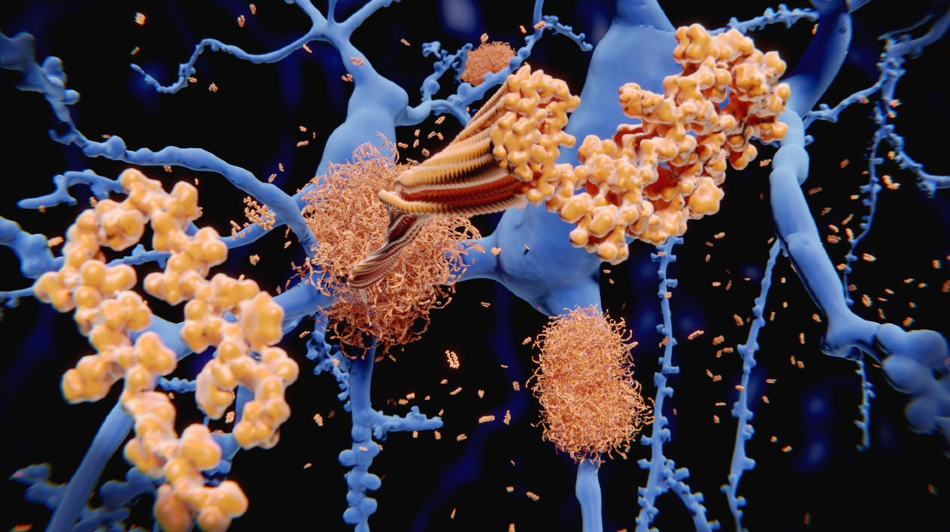Mar 13 2020
Robust tools have been designed by researchers at EPFL to unravel the diversity of amyloid fibrils that are linked to Alzheimer’s disease and other neurodegenerative disorders.

Image Credit: EPFL.
The researchers were able to achieve this breakthrough by creating gold nanoparticles that, in combination with cryogenic transmission electron microscopy, offer unparalleled and quick images of fibrils.
Alzheimer’s disease is characterized by the existence of knot-like structures between brain cells. These are known as “amyloid fibrils,” developed by the infamous amyloid-beta peptide and Tau protein, which are considered as the two most desired targets for the development of therapies to treat Alzheimer’s and analogous diseases.
In general, both Tau and amyloid-beta are synthesized in the brain. But these proteins can start getting twisted with each other to develop heavy fibril structures. When this occurs, disorders such as Alzheimer’s disease and other neurodegenerative diseases are the result.
The fibril structures get scattered all over the brain by shifting from one cell to another. This leads to the degeneration of neurons, resulting in brain damage and cognitive impairments such as memory loss. Therefore, the focus of research efforts taken by scientists has been on inhibiting these processes to delay the disease progression.
Researchers are now aware that these amyloid fibrils can occur in a variety of structures and shapes that have different properties, which could explain why Parkinson’s and Alzheimer’s disease patients exhibit different clinical symptoms.
As a result, capturing this dissimilarity and associating it with disease symptoms in humans or the biological activity of these species in disease models has vital implications for gaining insights into the mechanisms of disease and developing new diagnostics and therapies.
Since amyloid fibrils are highly crucial, several measures have been taken by researchers to visualize them in more detail to understand their structure.
Finding out the details of their structure could probably result in the determination of weak spots that can be aimed for treatment, thus providing the basis for designing diagnostic tools that are more reliable. Although a large number of studies have been performed, it has been highly challenging to capture and image the diversity of fibrils in biological samples. This is because of their heterogeneity and complex nature.
The Way of Gold (Nanoparticles)
At present, researchers from the groups of Francesco Stellacci and Hilal Lashuel at EPFL have resolved this issue. In a groundbreaking study reported in PNAS, the researchers demonstrated that gold amphiphilic anionic nanoparticles with a diameter of about 3 nm exhibit an exclusive ability to efficiently label the edge of amyloid fibrils in a hydrated state. This makes it easier to visualize the diverse amyloid fibrils.
The study was headed by PhD student Urszula Cendrowska and Dr Paulo J. Silva.
The researchers achieved this by imaging the nanoparticles-decorated fibrils with the help of a unique form of TEM known as “cryogenic transmission electron microscopy” (cryo-EM). The major difference in cryo-EM is that the sample (i.e., the fibrils) is initially frozen quickly to a very low temperature and can be observed in its “natural” state without the need to fix or stain in advance.
By using the capabilities of cryo-EM and the highly efficient binding of gold nanoparticles, the scientists could capture images of fibrils and reveal their diversity with unparalleled clarity. The visualized fibrils were grown in the laboratory and obtained from actual postmortem tissues of patients.
Our findings reveal a striking morphological difference between the fibrils produced in cell-free systems and those isolated from patients. This supports the current view that the physiologic environment plays a major role in determining different types of amyloid fibrils.
Francesco Stellacci, Researcher, EPFL
“These advances pave the way for elucidating the structural basis of amyloid strains and toxicity,” stated Lashuel.
The nanoparticles are powerful and desperately needed tools for rapid imaging and profiling of amyloid morphological polymorphism in different types of samples under cryo-conditions, especially complex samples isolated from human-derived pathological aggregates.
Hilal Lashuel, Researcher, EPFL